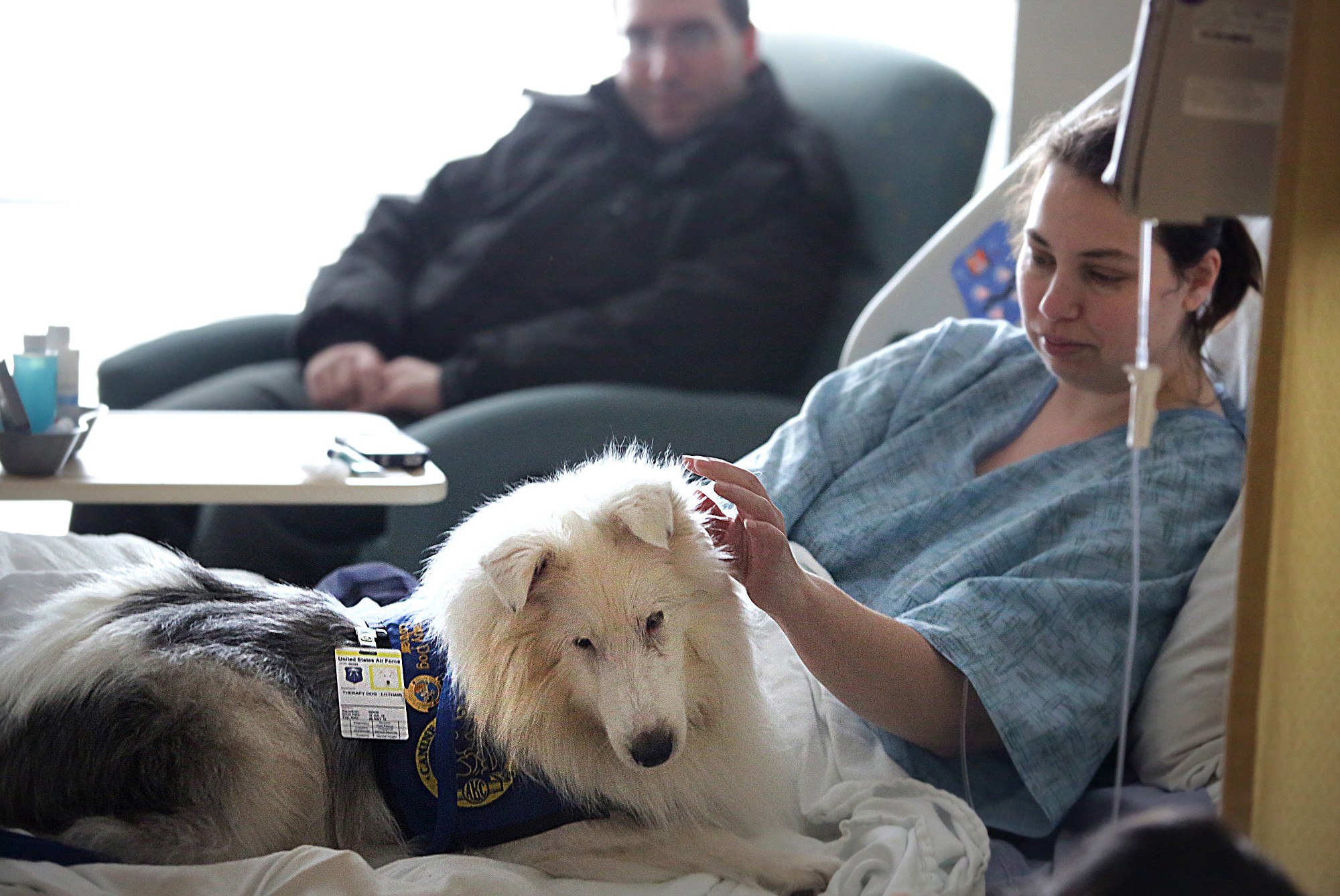NEWPORT NEWS, Va. — As Lothair, a white Sheltie therapy dog, makes his way in to U.S. Air Force Hospital Langley in Hampton, Va., for his weekly visit to meet with patients, he walks tall and proud into the building and is immediately greeted with a hug from a receptionist at the front desk.
Lothair continues walking down the hall, carrying himself like royalty, appropriate for a dog named after a French monarch. From the time the dog was a puppy, he had a proud, dignified air about him, said his owner, Hampton resident Melanie Paul.
“He was beautiful,” she said. “He was like a king.”
Watching the way Lothair moves and interacts with patients at the hospital, it is not obvious that Lothair has been deaf since birth.
“Deafness is an invisible disability,” she said via email.
Lothair began serving as a therapy dog — providing emotional support to patients in hospitals, nursing homes and other settings — several years ago.
He is registered with New Jersey-based Therapy Dogs International, which has dogs registered in all 50 states and Canada. Along with tests required by the organization to become a certified therapy dog, deaf dogs must also undergo a startle test. During the test, someone will come up behind the dog, and pet and touch its rear quarters, and the dog must not be startled or react negatively, TDI’s website states.
Paul has had therapy dogs for more than 15 years. She started a pet therapy program at Sentara CarePlex Hospital in Hampton more than a decade ago and started the same program at Langley Air Force Base about five years ago.
She usually brings Lothair and another therapy dog to Langley once or twice a week and also makes regular visits to local hospitals and nursing homes.
Paul decided to acquire a deaf dog as she prepared to retire from Virginia School for the Deaf and Blind in 2009 after a 30-year career in education, intending to use the dog to help deaf children improve their literacy skills, she said.
She ended up taking in Lothair as a 3-month-old puppy. Both of his parents are Blue Merle Sheltie champion show dogs, and breeding them together increases the likelihood at least one of their puppies will be deaf or deaf and blind, she said.
Paul, who became deaf at 12 after incorrectly being diagnosed with an illness and being prescribed the antibiotic streptomycin, said there tends to be some hesitation among some deaf people to have a deaf dog, as they end up relying on the dogs to hear for them. However, because her husband as well as her other dogs can hear, that wasn’t an issue for her.
“In fact, maybe because of the affinity that the puppy would also be deaf, ‘just like me,’ I enthusiastically looked forward to the experience of adopting and raising a deaf dog,” Paul wrote in a 2011 article about Lothair published in Sheltie Pacesetter magazine.
When she didn’t see results from traditional obedience school, Paul taught Lothair American Sign Language, and created her own signs, applying techniques used to teach deaf children, Paul explained in the article.
In training Lothair, her other dogs learned the signs, too.
During a recent trip to Langley, Lothair paid a visit to Rebecca Bennett-Jordan, who underwent a hysterectomy that morning and was waiting to see when she’d be able to go home.
Bennett-Jordan, who has three cats, said Lothair’s visit was unexpected but welcome.
“I love it,” she said as she petted Lothair in her bed. “I’m an animal person.”
Next, Lothair spent time with Abygale Morris, who was in the hospital for asthma treatment on the eve of her 10th birthday.
“Hope you’ll be feeling better,” Paul told Abygale.
“We’re trying,” responded Abygale’s mother, Rebecca, as she knitted a sock.
Lothair’s visit led Abygale to reminisce about pet dogs the family used to have.
“It’s nice they bring the dogs in,” she said.
Staffers at the hospital enjoy Lothair’s visits as much at the patients do.
“The therapy is not just for the patients; it’s for us, too,” said Monique Rolle, a civilian registered nurse. “I wish they came more often.”
Knowing that those at the hospital look forward to seeing the dogs motivates Paul week after week.
“It warms my heart when I see patients, staff and visitors smile, their faces light up and are so happy to see my dogs when we do visits,” Paul said via email.
“The individual happiness of patients stays with me long after I have completed the visit.”



